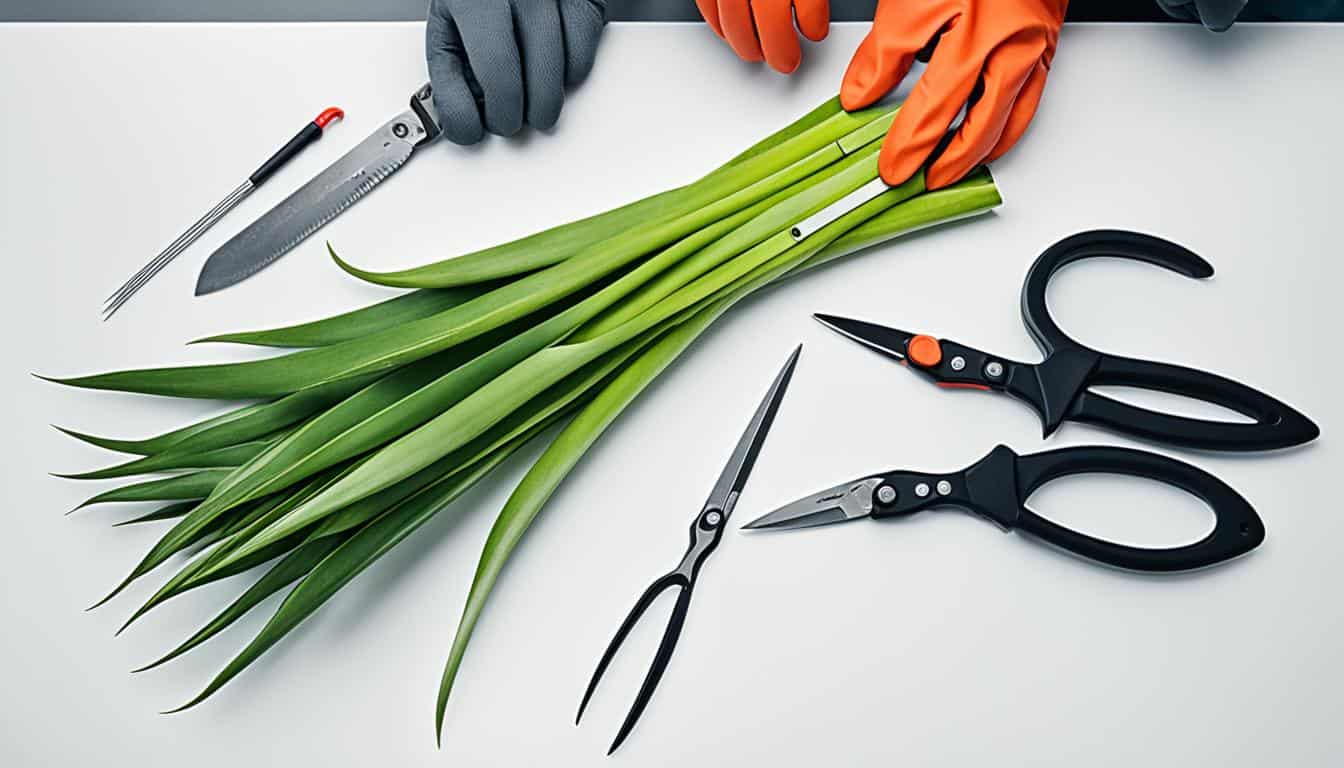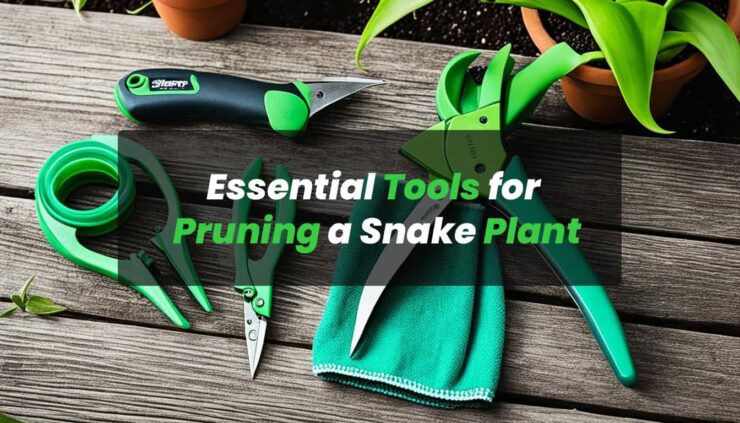Do you know What are the essential tools for pruning a snake plant? Maintaining your snake plant’s health and look is key. The right pruning tools help care for these beautiful succulents properly. But, what tools do you need for perfect pruning?
Start with pruning shears or sharp scissors. They cut cleanly, reducing harm and preventing sickness. Don’t forget to disinfect your tools to stop pests and diseases.
Your hands need protection too since snake plants have mildly toxic sap. Wearing gardening gloves keeps your skin safe. For tricky spots, long-handled pruners and tweezers are great.
With the best tools and skills, you’ll keep your snake plant flourishing. Let’s look closer at how to prune your snake plant like a pro.
Here we’ll explore you Which Tools Are Required for Pruning a Snake Plant
Pruning a snake plant is more than just a trim; it’s a health boost too. It helps remove the unhealthy parts so new leaves can grow. This process keeps the plant looking good and in the best shape.
By trimming, you make sure the snake plant stays healthy and lively. Doing this regularly keeps it growing happily.
Benefits of Pruning Snake Plant
Properly pruning your snake plant gives it many advantages:
- Encourages New Growth: Cutting back the plant makes it produce new leaves and grow more.
- Maintains Shape and Structure: It keeps your plant nice and prevents it from looking messy.
- Improves Overall Health: It helps the plant focus its energy on growing well and fighting sickness.
- Reduces Pests and Diseases: By cutting off unhealthy parts, you take away places for bugs to live and diseases to spread.
- Promotes Blooming: For plants that flower, the right cuts can help them bloom more.
Keeping up with pruning snake plant ensures it stays fresh and lively for many seasons.
“Regular pruning is an essential part of caring for a thriving snake plant.”
When to Prune Snake Plant?
Pruning your snake plant at the right time keeps it healthy and looking good. It’s best to prune when the plant is growing most, like in spring or early summer.
At this time, the snake plant can handle cutting without issue. It will grow back even better, possibly with flowers. This makes your plant look shiny and new.
Before you start cutting, check if your plant is already not doing well. If it’s not healthy, it needs care before you prune. Healthy snake plants can be pruned gently every few years.
Choosing the right time to prune is key. By doing it during the active growing phase, your snake plant will look great for years.
Essential Tools for Pruning a Snake Plant
To keep your snake plant healthy, use the right tools. Make sure you have them before starting to prune. Having the right equipment is key for a well-maintained plant.
Pruning Tools Tips
Here are some tips to help you keep your snake plant in great shape:
- Keep Pruning Tools Sharp: Get a pair of sharp scissors or shears. Clean cuts are crucial for the plant’s well-being.
- Disinfect Tools Between Cuts: Clean your tools after each cut. This stops diseases. Use a diluted bleach solution or a garden disinfectant.
- Prune Only When Necessary: Don’t prune too often. It can stress the plant. Only prune when you see dead or damaged leaves.
- Use Clean Cuts: Cut close to the soil with clean, precise cuts. It helps the plant recover fast and stay healthy.
- Monitor Growth Patterns: Keep an eye on how your snake plant grows. This tells you when it needs pruning. It keeps the plant looking good.
Following these tips will make your snake plant live long and stay beautiful.
“Proper pruning is essential for the long-term health and appearance of your snake plant.”
Pruning Techniques
Proper pruning is key for a healthy snake plant. Beyond cutting off bad leaves, the method you use matters a lot. We will explore the main steps for a successful pruning process.
Selecting Your Tools
First, pick the right tools. You need sharp shears or scissors for clean cuts. Dull tools can harm the plant. Always clean your tools to stop disease spread.
The Pruning Process
Start by cutting off damaged leaves at their base. Try not to cut in the middle of leaves. Keep in mind not to cut off too much at once to avoid stressing the plant.
Technique Matters
Each cut should be neat and at a slight angle. Aim to make the plant look nice and cut above healthy areas. This helps the plant recover faster.
Post-Pruning Care
After pruning, care for your snake plant well. It needs a warm, bright spot but not direct sun. Water only a little and watch for any issues. With the right treatment, your plant will thrive again.

“Proper pruning is an art form, and with a little practice, you’ll be able to give your snake plant the care it deserves.”
Challenges in Pruning
Pruning your snake plant is a delicate job. The line between good trimming and harm is thin. Knowing the problems like over-pruning, under-pruning, and proper cuts is key. It helps your plant stay healthy after trimming.
Over-Pruning: Less is More
Resist the urge to give your snake plant a big cut. Too much at once can stress it. This can slow growth and make it easier for diseases and bugs to attack. Cut back only as much as needed to keep your plant healthy and growing well.
Under-Pruning: Spot the Culprits
Not cutting your snake plant enough can also be bad. Dead, sick, or discolored leaves use up the plant’s energy. They stop new leaves from growing. So, always check your plant for leaves that need to go.
The Right Cut
When you cut your plant, make sure the cuts are clean and close to the soil. Bad cuts can make the plant sick. Always use sharp, clean shears. Cut at an angle to help the plant heal faster.
Post-Pruning Care
After pruning, your snake plant will need extra care. Give it the right light and water. Avoid sudden changes that might stress the plant. With good care after trimming, your snake plant will look great again soon.
Disease and Pest Control
Pruning helps keep disease and pests at bay in your snake plant. Remove any bad leaves. But remember, you need to fix the main problems too. Keep an eye out and act early to protect your snake plant.
“Achieving the right balance in pruning is essential for the long-term health and well-being of your snake plant.”
Propagation from Cuttings
Unlocking propagation helps grow your snake plant collection. You can make new plants from cuttings. Or you might just want to make your garden more diverse. Learning how to do this is a valuable skill. There are different ways to make more snake plants. We’ll look at these methods here.
Snake plants are great for trying different propagation methods. You can try growing them in water or in soil. Water propagation is easy. You put a cutting in water and roots will grow. Then there’s soil propagation. You plant cuttings in soil. They grow roots and start to live on their own.
If you want to make new plants fast, try rhizome propagation. This method uses the plant’s underground stems. It makes new plants that are just like the original. It’s especially good for keeping the special patterns of some snake plant types.
| Propagation Method | Advantages | Considerations |
|---|---|---|
| Water Propagation | Easy, visually engaging | Slower root development |
| Soil Propagation | Faster root establishment | Requires well-draining soil |
| Rhizome Propagation | Maintains variegation, faster growth | Requires dividing underground stems |
No matter which way you choose, working with cuttings is fun. You need a bit of patience and to use the right methods. Soon, your snake plants will be growing strong in your home.
“Propagation is the key to unlocking the full potential of your snake plant collection.”
Pruning for Pest and Disease Management
Pruning is key to keeping your snake plant healthy. By cutting off diseased parts, you stop pests and diseases. This way, pruning acts as pest control and keeps your plant safe.
The Art of Pruning as Pest Control
Checking your plant often is important for fighting pests. If you see bugs or their signs, like different colored leaves, cut those parts off quickly. This timely pruning stops the issue from spreading and makes the plant less welcoming to bugs.
Disease Prevention: A Snip in Time Saves Nine
Cutting your plant can also keep diseases away. Thinning the leaves lets air flow better, which lowers the chance of fungi and bacteria. This disease prevention method is like fixing a small tear before it becomes a big hole.
Timing is Everything
Choosing the right time to prune is crucial. It’s best to do it when the plant isn’t actively growing. That means late winter or early spring for snake plants. This timing protects the plant from new pests and issues.
Pruning with Precision
Using the right tools and cutting correctly is vital. A sharp, clean cut is important to prevent diseases. Make sure to trim properly, leaving no open spots for pests.
By following these steps on the art of pruning and using disease prevention, timing, and pruning with precision, you can keep your snake plant healthy. This will ensure it thrives for years.
Final Thought on Tools for Pruning a Snake Plant
Learning to prune a snake plant is crucial for its well-being. With the right tools and knowing when to prune, the plant will be healthy and look good. Pruning helps more than just making the plant prettier. It keeps the plant in check, helps it grow, and keeps away bugs and plant illnesses. It also makes new plants.
Give your snake plant some care, and it will fill your space with beautiful leaves for years. Remember, the trick to pruning is balance. Not too much, not too little. Use the right methods and care after pruning to keep your snake plant happy and thriving.
Pruning your snake plant can lead to amazing results. Done right, your plant will not only be pleasing to the eye but also live longer and healthier.





Add comment